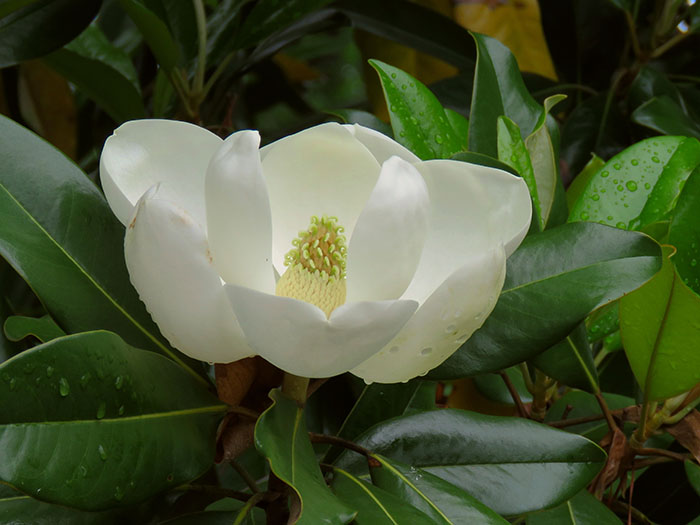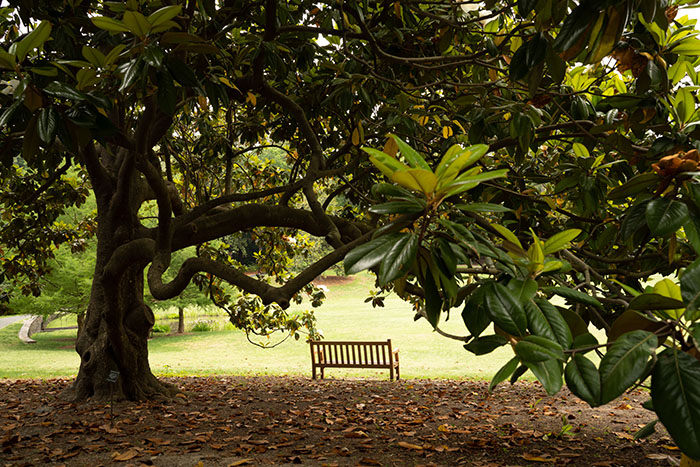Garden Talk

Botanical name: Magnolia grandiflora
Common name: Southern magnolia
Family name: Magnoliaceae (Magnolia family)
Native range: Southeastern United States
Location in Duke Gardens: Historic Gardens
USDA Hardiness Zones: 6-10
By Katherine Hale
Marketing & Communications Assistant

Step under the canopy of a mature Southern magnolia (Magnolia grandiflora) and discover a different world, one perpetually sheltered by the huge, spreading lower limbs and the shady evergreen canopy overhead, and where a dense carpet of leathery fallen leaves crunches underfoot. Left to its own devices, each Southern magnolia tree eventually becomes an island unto itself, spreading outward and upward like an arboreal octopus over time. Striking at any time of year, the Southern magnolia is especially magical in May and June, when white waxy flowers bloom up to a foot in diameter, exuding a heady lemony fragrance that is nothing short of heavenly.
Magnolias are one of the oldest lineages of flowers in existence—so ancient they predate the evolution of bees and butterflies, and they were pollinated by beetles instead. While there are many kinds of insects that visit magnolia flowers now, this original relationship continues to this day, and it’s very common to find a large shiny beetle or two writhing around inside Southern magnolia flowers, completely coated with yellow pollen from anthers the size and shape of matchsticks. This is one reason why the carpels, or female portions at the center of magnolia flowers, are especially thick and robust compared to plants from other families—so that they are less likely to be damaged by these especially heavy and often clumsy insects.
Magnolias are also old enough to predate the formation of North America and the Asian continents, which were originally part of the same large landmass millions of years ago. Thus, magnolias are now concentrated in these two regions, despite being separated by thousands of miles and many geographic obstacles. As you can imagine, this long history of separation and isolation makes magnolia taxonomy and classification extremely complex, with scientists increasingly using genetic analyses to divide species and sections within Magnolia and related genera.
An iconic symbol of the American South, Southern magnolias are perhaps most famous for the huge and historic specimens in coastal cities like Charleston and Savannah—part of the original “magnolia belt” stretching from the eastern Carolinas through Florida and west to Texas. However, the species has been widely planted outside its original range, including here at Duke Gardens, and it has naturalized farther north and farther inland in recent decades as the overall climate continues to warm. While many people consider Southern magnolia to be a native plant, whether that is actually true in any given case depends on the location, time frame and perspectives involved.
These days, Southern magnolias are seemingly everywhere, widely cultivated as an ornamental specimen, a street tree and as a commercial timber species. Because mature trees take up so much space in warmer climates, they are at their best in parks or open fields that will give them plenty of room to grow, unless a dwarf cultivar like ‘Little Gem’ is selected. Even here, “small” is relative—30 years down the road, it will be approximately 15 feet high, as opposed to the 50 or more for a wild-type. Gardeners in more temperate areas have less to worry about on that front, as colder winters naturally limit this species’ vigorous growth, and in fact they may kill planted trees completely unless a cold-tolerant cultivar and sheltered planting location is chosen.
While the Southern magnolias at Duke Gardens are beloved—and rightly so—they are also vulnerable to being “loved to death” by the hundreds of thousands of visitors Duke Gardens welcomes each year. A Southern magnolia tree in the South Lawn that was originally planted in 1938 had to be removed in 2001 due to an extensive decline after visitors damaged the bark and compacted the surrounding soil through climbing and other activities. Tree climbing is prohibited at Duke Gardens. We ask visitors to be respectful of these incredible trees, and all trees, so that they can be enjoyed by everyone for decades to come.
Photos from top: A close-up of a Southern magnolia flower in the Historic Gardens, by Sue Lannon; profile of a Southern magnolia on the South Lawn, by John Geneczko Jr.; a wooden bench under a magnolia tree in the South Lawn, by Clarence Burke.






